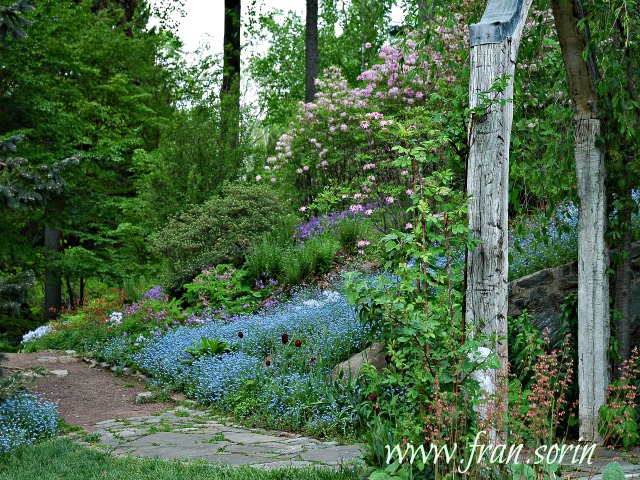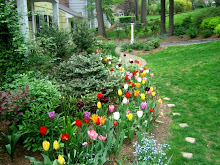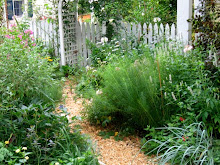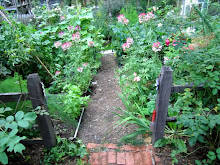
~
Much to my surprise, I've recently attracted a lot of traffic to my prior posts on pruning roses and hydrangeas. My advice? Wait until late winter/early spring. I do absolutely no pruning of hydrangeas at this time of year and the only pruning of roses that I do is either of completely dead wood or canes that have grown so tall that they are likely to break in the winter winds and damage the rest of the plant. For more information, click below:
~
Hydrangeas: Why and How to Prune
How to Prune Roses, Part I: An Introduction
How to Prune Roses, Part II: Old Rose Pruning Secrets
How to Prune Roses, Part III: Why Prune?
Welcome to Heirloom Gardener
Friday, November 14, 2008
"Put the Pruners Down and Step Away": Autumn is not the Time to be Pruning your Roses and Hydrangeas
Posted by
Julia Erickson
at
10:30 AM
5
comments
![]()
![]()
Labels: Autumn Garden, Hydrangeas, Pruning and Maintenance, Roses
Thursday, November 13, 2008
Autumn Beauty: The Last Clematis

Posted by
Julia Erickson
at
11:02 AM
2
comments
![]()
![]()
Labels: Clematis
Wednesday, November 12, 2008
Tuesday, November 11, 2008
Perhaps we garden bloggers can help remember our veterans and war dead by posting a picture of a poppy today?
 Many years ago, on my first trip to the U.K. during this time of year, I was struck by the fact that everyone from all walks of life wears artificial poppies in honor of those who died at war for Remembrance Day or Poppy Day. I later learned that these artificial poppies are sold as an annual fundraiser by the Royal British Legion, a charity dedicated to helping war veterans.
Many years ago, on my first trip to the U.K. during this time of year, I was struck by the fact that everyone from all walks of life wears artificial poppies in honor of those who died at war for Remembrance Day or Poppy Day. I later learned that these artificial poppies are sold as an annual fundraiser by the Royal British Legion, a charity dedicated to helping war veterans.
~
According to Wikipedia: "The poppy's significance to Remembrance Day is a result of Canadian military physician John McCrae's poem In Flanders Fields. The poppy emblem was chosen because of the poppies that bloomed across some of the worst battlefields of Flanders in World War I, their red colour an appropriate symbol for the bloodshed of trench warfare. A Frenchwoman, Anna E. Guérin, introduced the widely used artificial poppies given out today."
~
In the U.S., we celebrate Veterans' Day today for the living and reserve Memorial Day in May for the dead. Unfortunately, we do too little--we do not wear poppies or pause for two minutes of silence at eleven o'clock--on both of these holidays to truly celebrate, remember, or honor those who served and returned or those who died. Fortunately, Zoe over at Garden Hopping helped me to remember this holiday today with a picture of a poppy and this poem: Garden Hopping: Lest We Forget.
Posted by
Julia Erickson
at
11:00 AM
1 comments
![]()
![]()
Labels: Gardening Blogs, Holidays, Poppies
Autumn Beauty: Grasses in my Mixed Borders
There was a time when I didn't think I liked grasses in the garden. Then, I visited the Cutler Botanical Garden in Binghamton, New York, and I was taken by the beautiful display grasses that they have there. Now, I have grasses in grasses in most of my mixed borders, and they are particularly lovely in autumn with their plumes, as you can see below. These pictures were taken about ten days ago and the grasses are now turning color from summer green to winter straw. I'll leave the grasses up for the next couple of months to provide some winter interest before cutting them down at the end of the winter/beginning of spring before the new growth begins.
~
Posted by
Julia Erickson
at
12:01 AM
2
comments
![]()
![]()
Labels: Autumn Garden, Mixed Borders
Monday, November 10, 2008
Sunday, November 09, 2008
How to Make a Planting Square to Uniformly Space Your Seeds
Do you ever wonder how you are supposed to uniformly space your seeds so many inches apart, as described in the planting instructions?
Well, last month, on a visit to the Family Garden at the New York Botanical Garden (NYBG), I noticed that they had these neat planting squares to do just that, which is particularly important to do when your amount of space is limited. With that inspiration and some additional thoughts of what would be helpful to me, I asked my husband to make one. The basic idea was a picture frame with a twelve inch by twelve inch opening with pegs placed at two, three, four, six, eight, nine, and ten inches to facilitate planting seeds two, three, four, or six inches apart. I also requested that it be weather-proof, as it may be left in the garden from time-to-time.
After getting the materials together at a cost of less than ten dollars, my husband was able to build the planting square in less than one hour. Here's how he did it.



Posted by
Julia Erickson
at
11:00 PM
3
comments
![]()
![]()
Labels: Gardening Tools and Structures, Heirloom and Organic Food, Propagation and Seeds
Saturday, November 08, 2008
In Praise of Blotanical: Where Garden Blogs Bloom
There are many places on the find gardening blogs: the broadest Google searches, the more narrow Technorati blog-only searches, and to numerous gardening-specific websites. Of all of these, I find that the best by gardeners and for gardeners is Blotanical. They have all sorts of ways of presenting blogs by popularity, location, etc. Recently, they even announced their first-ever Blotanical Awards.
Posted by
Julia Erickson
at
12:01 PM
2
comments
![]()
![]()
Labels: Online Gardening Resources
Friday, November 07, 2008
How to Grow Flowers on a Military Base in Iraq
Imagine that you are a committed gardener and find yourself stationed in Iraq in the middle of a desert. What would you do?
The post: http://www.instructables.com/id/How_to_grow_flowers_on_a_military_base_in_Iraq/
The author's blog: http://www.spf400.blogspot.com/
Pray for our troops and their families around the world.
Posted by
Julia Erickson
at
10:09 AM
3
comments
![]()
![]()
Interview with Lawrence Griffith, Colonial Williamsburg's Curator of Plants and Author of Flowers and Herbs of Early America
As I wrote in a prior post, I very much enjoyed Flowers and Herbs of Early America by Lawrence Griffith, Colonial Williamsburg's Curator of Plants. After my short review, Lawrence and I got in touch and he agreed to answer a few questions.
~
Q. First, I'd love to hear about how you became a gardener, particularly a gardener interested in heirloom plants.
~
A. My grandparents had a summer home in New Milford, Connecticut, in the Berkshires. I was very beautiful. We had a 20-mile view into the Litchfield Hills. My grandmother was a gardener and introduced me to the culture. The Green thumb skips a generation. My mother was an enthusiastic, but no avid. The house stood on a six acre former milk cow pasture, so the soil was unbelievably fertile. I never fertilized. And then I was loaned out to gardening neighbors who taught me to garden, weekend-New York people. So I did everything the old fashionable way, wettable powers, etc.
~
Q. What was the impetus for the book?
~
A. In 2001 I was the recipient of a Mars Foundation grant that allowed me to study heirloom plants. It funded 3 years of live field trials, and 3 years of research. While I gardened, Barbara Lombardi, the photographer, would photograph behind me. And we put two and two together and came up with a project.
~
Q. What are your five favorite plants in the book for the home gardener and why?
~
A. Adonis (Adonis aestivalis) is a cool season annual with millennia of history behind it. If the seed is sown by the middle of March its cherry red blossoms emerge by the middle of June. Fall sown Adonis will germinate in the fall and survive the winter to bloom the following spring, like such things as Calendula, English daisies, and wallflower. It’s cheery, about 18” tall, with very attractive ferny foliage.
~
I like the China aster (Callistephus chinensis), a late season annual, because of the relatively large size of the flowers in comparison to other antique plants. They make very good cut-flowers, and bloom at a time when the asters and late perennial sunflowers are blooming. China asters are typically blue, white and pink and either single or double. Gardeners who plant seed in the spring should expect flowers by the end of August.
~
Cypress vine (Ipomoea quamoclit) is a tropical annual vine from the West Indies. ‘Cypress’ refers to the very fine foliage of the vine, also known Cardinal Vine. It also has bright red flowers, about ½” across, and if planted in masses it can cover a long picket fence. One caveat is that it is very prolific with its seed and can become a pest.
~
I enjoyed the annual larkspur (Consolida ambigua) the most because it did the best job in reseeding. The aim of the Mars Foundation grant was to find crops of flowers that would reseed and come back the following spring. Larkspur now is germinating in my garden at home, the genesis for next year’s crop. Larkspur flowers in white, blue and pink and great masses of it can be achieved if it is left to yellow and set seed, and then disperse it.
~
The scarlet pentapetes (Pentapetes phoenicia) is a tropical annual, with scarlet flowers, that grows to five feet, and is given to reseeding. In addition to its stellar flowers, its serrated foliage is a deep glossy green. This and the cypress vine abhor chilly weather and the gardener is urged to wait until the end of May to attempt seed germination.
~
Q. What do you hope a reader gets from the book and why?
~
A. I want the reader to know of the real beauty in older, smaller flowers. Prior to the great age of hybridization for larger flower size and longer duration of bloom, simpler flowers delighted millions. Barbara’s photographs really enhance the architectonic aspect of many flower forms and gives some glimpses into the origins of common names that have been attached to them throughout time.
~
I’d like the gardener to become a little aware of the history of botany, that our plant legacy started with the ancients, and has become amended over time. The colonial plant palette still incorporates much of the Greco-Roman herbal, and I find that intrinsically interesting.
~
I’d like the gardener to know of the rewarding experience of growing flowers and herbs from seeds, sown directly into the ground. While initially planting and thinning seedlings can be tedious, a gardener can easily amass a collection of dozens of species without undo expense.
~
Q. In a world gone mad with politics and financial meltdown, what does gardening do for our peace, quiet and sanity? What do you tell younger adults who may ignore its beauty and pleasure?
~
A. Like any other task, I think gardening can be meditative, if the mind concentrates on the task at hand. Frankly, I’d rather be bothered by lawn mower and tractor problems, vole problems, and drought, than the ups and downs of the market. A well manicured yard is a peaceful thing for me to observe and probably does more to restore my soul than anything else.
~
Younger adults need to look beyond the ‘hard work’ aspect of gardening. As younger adults mature, they begin to learn that in the myriad ‘dull’ spots in life, a hobby, such as gardening, can be fulfilling.
~
And gardening can be done on every scale, from landscape development to window box gardening. I don’t think you can ‘get the bug’ without some hands on, or a familial tie, such as I had with my grandmother who taught me the sheer beauty of landscape and gardens.
Posted by
Julia Erickson
at
12:01 AM
0
comments
![]()
![]()
Labels: Books and Movies
Thursday, November 06, 2008
A Lattice Screen to Hide My Gardening Supplies and Grow Clematis
Back in August, the Garden Bloggers' Design Workshop at Gardening Gone Wild focused on Trellises and Screens. I didn't get around to contributing at that time, but one thing that Nan wrote in the wrap-up compelled me to add something to the conversation.
In addition to those beneath my deck, I have trellises and screens in two other parts of my garden: (i) in the Cutting Garden next to the chimney (pictured below) which provides a place to grow the vigorous rose Complicata and (ii) on the deck in containers to provide privacy from the next door neighbors on which I grow annual vines (this year, I grew Moon flowers).

Posted by
Julia Erickson
at
7:28 PM
2
comments
![]()
![]()
Labels: Clematis, Fences Arbors Walls and Paths, Garden Bloggers' Design Workshop
Autumn Beauty: Clematis Seed Heads
Posted by
Julia Erickson
at
12:01 PM
3
comments
![]()
![]()
Labels: Autumn Garden, Clematis, Seed Heads
Search Heirloom Gardener
Labels
- About Blogging
- Annuals/Biennials and Perennials
- Autumn Garden
- Books and Movies
- Botanical Gardens
- Bulbs and Tubers
- Children's Garden
- Chrysanthemum
- Clematis
- Container Gardening
- Crocus tommasiniasus roseus
- Cut and Forced Flowers
- Cutting and Rose Gardens
- Dahlias
- Deep Thoughts About Gardening
- Egg Garden
- Fences Arbors Walls and Paths
- Floral arrangements
- Front Border
- Fun Stories About Gardening
- Garden Bloggers' Bloom Day
- Garden Bloggers' Design Workshop
- Garden Planning
- Gardening Blogs
- Gardening Tools and Structures
- Gardening with Children
- Goldberry Hill
- Heirloom and Organic Food
- Hibiscus
- Holidays
- Hydrangeas
- Japanese Beautyberry
- Lilies
- Mixed Borders
- New Jersey / Local Interest
- Nurseries
- Online Gardening Resources
- Peonies
- Pest Control
- Picture This Photo Contest
- Piet Oudolf
- Poppies
- Propagation and Seeds
- Pruning and Maintenance
- Roses
- Seed Heads
- Self Seeders
- Shrubs
- Spring Garden
- Summer Garden
- Trees
- Wildlife in the Garden
- Winter Garden
- Zinia






































